Analysis of Decision-Making Tools and Flowcharts in Nursing Practice
VerifiedAdded on 2020/06/06
|9
|2980
|32
Report
AI Summary
This report provides a critical analysis of decision-making tools and associated flowcharts used in nursing practice, focusing on their contribution to effective clinical decision-making. It discusses various tools such as decision boxes and option grids, highlighting their role in assisting nurses in providing high-quality patient care, particularly in acute care settings. The report examines the national decision-making framework and its impact on the nursing workforce, emphasizing the importance of evidence-based decisions and adherence to professional standards. An illustration is provided, showcasing a clinical decision made by a qualified nurse regarding a patient with chest pain, demonstrating the application of decision-making tools and ethical considerations in practice. The report emphasizes the significance of these tools in promoting patient safety, shared decision-making, and the continuous improvement of nursing practice within a changing healthcare environment. The report also touches upon how flowcharts help in the rational process of making decisions within a sound risk management, professional, regulatory, and legislative framework.

Critical Thinking
&
Analysis
&
Analysis
Paraphrase This Document
Need a fresh take? Get an instant paraphrase of this document with our AI Paraphraser
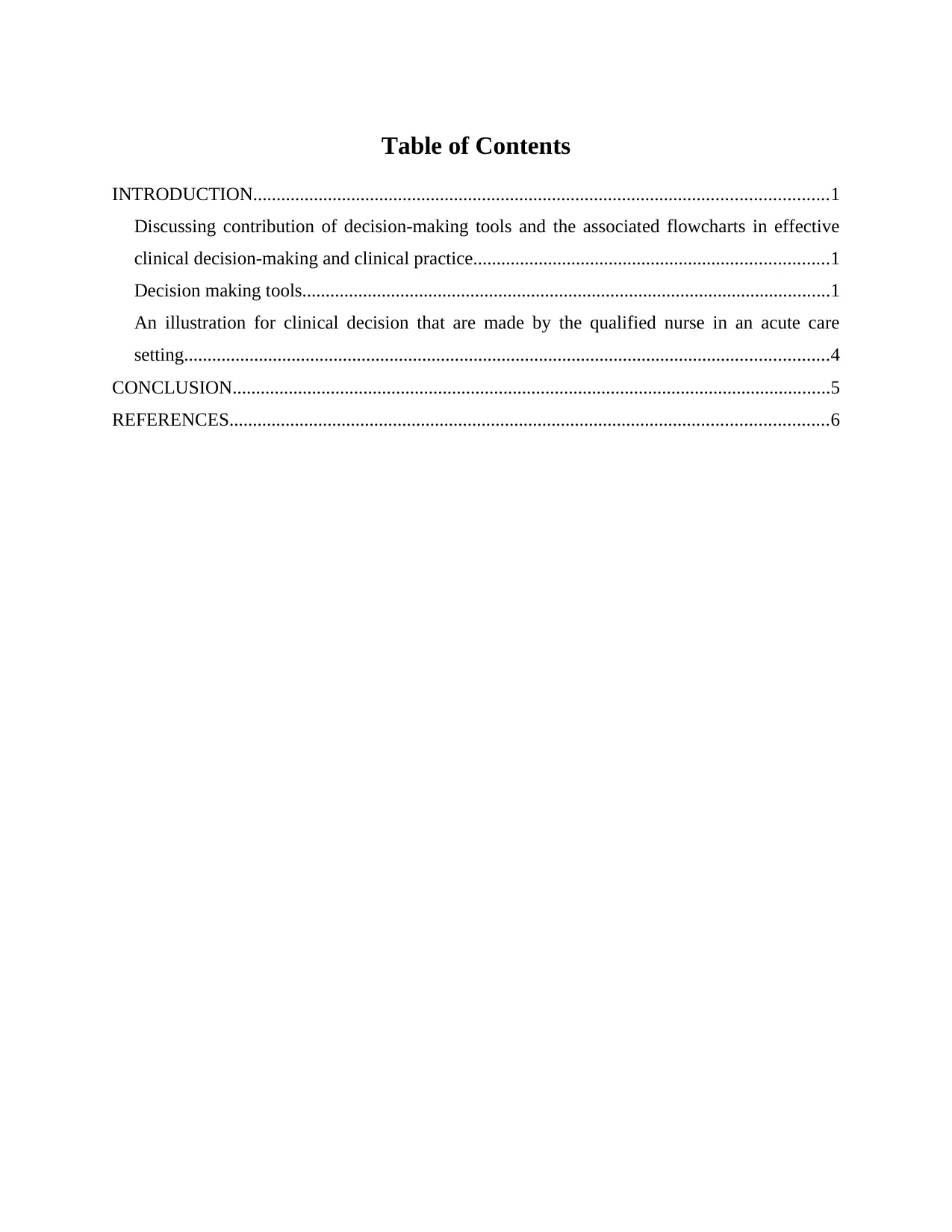
Table of Contents
INTRODUCTION...........................................................................................................................1
Discussing contribution of decision-making tools and the associated flowcharts in effective
clinical decision-making and clinical practice............................................................................1
Decision making tools.................................................................................................................1
An illustration for clinical decision that are made by the qualified nurse in an acute care
setting..........................................................................................................................................4
CONCLUSION................................................................................................................................5
REFERENCES................................................................................................................................6
INTRODUCTION...........................................................................................................................1
Discussing contribution of decision-making tools and the associated flowcharts in effective
clinical decision-making and clinical practice............................................................................1
Decision making tools.................................................................................................................1
An illustration for clinical decision that are made by the qualified nurse in an acute care
setting..........................................................................................................................................4
CONCLUSION................................................................................................................................5
REFERENCES................................................................................................................................6
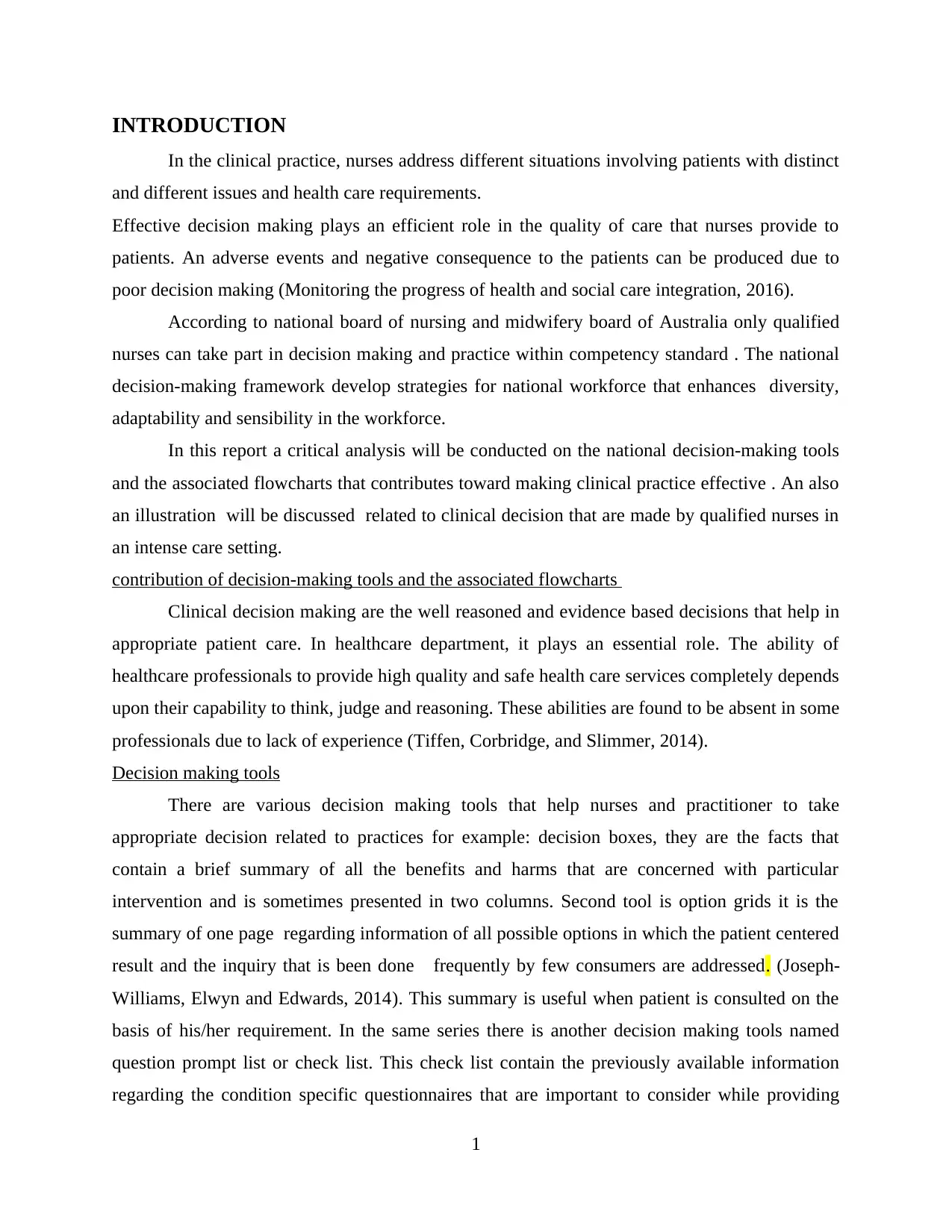
INTRODUCTION
In the clinical practice, nurses address different situations involving patients with distinct
and different issues and health care requirements.
Effective decision making plays an efficient role in the quality of care that nurses provide to
patients. An adverse events and negative consequence to the patients can be produced due to
poor decision making (Monitoring the progress of health and social care integration, 2016).
According to national board of nursing and midwifery board of Australia only qualified
nurses can take part in decision making and practice within competency standard . The national
decision-making framework develop strategies for national workforce that enhances diversity,
adaptability and sensibility in the workforce.
In this report a critical analysis will be conducted on the national decision-making tools
and the associated flowcharts that contributes toward making clinical practice effective . An also
an illustration will be discussed related to clinical decision that are made by qualified nurses in
an intense care setting.
contribution of decision-making tools and the associated flowcharts
Clinical decision making are the well reasoned and evidence based decisions that help in
appropriate patient care. In healthcare department, it plays an essential role. The ability of
healthcare professionals to provide high quality and safe health care services completely depends
upon their capability to think, judge and reasoning. These abilities are found to be absent in some
professionals due to lack of experience (Tiffen, Corbridge, and Slimmer, 2014).
Decision making tools
There are various decision making tools that help nurses and practitioner to take
appropriate decision related to practices for example: decision boxes, they are the facts that
contain a brief summary of all the benefits and harms that are concerned with particular
intervention and is sometimes presented in two columns. Second tool is option grids it is the
summary of one page regarding information of all possible options in which the patient centered
result and the inquiry that is been done frequently by few consumers are addressed. (Joseph-
Williams, Elwyn and Edwards, 2014). This summary is useful when patient is consulted on the
basis of his/her requirement. In the same series there is another decision making tools named
question prompt list or check list. This check list contain the previously available information
regarding the condition specific questionnaires that are important to consider while providing
1
In the clinical practice, nurses address different situations involving patients with distinct
and different issues and health care requirements.
Effective decision making plays an efficient role in the quality of care that nurses provide to
patients. An adverse events and negative consequence to the patients can be produced due to
poor decision making (Monitoring the progress of health and social care integration, 2016).
According to national board of nursing and midwifery board of Australia only qualified
nurses can take part in decision making and practice within competency standard . The national
decision-making framework develop strategies for national workforce that enhances diversity,
adaptability and sensibility in the workforce.
In this report a critical analysis will be conducted on the national decision-making tools
and the associated flowcharts that contributes toward making clinical practice effective . An also
an illustration will be discussed related to clinical decision that are made by qualified nurses in
an intense care setting.
contribution of decision-making tools and the associated flowcharts
Clinical decision making are the well reasoned and evidence based decisions that help in
appropriate patient care. In healthcare department, it plays an essential role. The ability of
healthcare professionals to provide high quality and safe health care services completely depends
upon their capability to think, judge and reasoning. These abilities are found to be absent in some
professionals due to lack of experience (Tiffen, Corbridge, and Slimmer, 2014).
Decision making tools
There are various decision making tools that help nurses and practitioner to take
appropriate decision related to practices for example: decision boxes, they are the facts that
contain a brief summary of all the benefits and harms that are concerned with particular
intervention and is sometimes presented in two columns. Second tool is option grids it is the
summary of one page regarding information of all possible options in which the patient centered
result and the inquiry that is been done frequently by few consumers are addressed. (Joseph-
Williams, Elwyn and Edwards, 2014). This summary is useful when patient is consulted on the
basis of his/her requirement. In the same series there is another decision making tools named
question prompt list or check list. This check list contain the previously available information
regarding the condition specific questionnaires that are important to consider while providing
1
⊘ This is a preview!⊘
Do you want full access?
Subscribe today to unlock all pages.

Trusted by 1+ million students worldwide
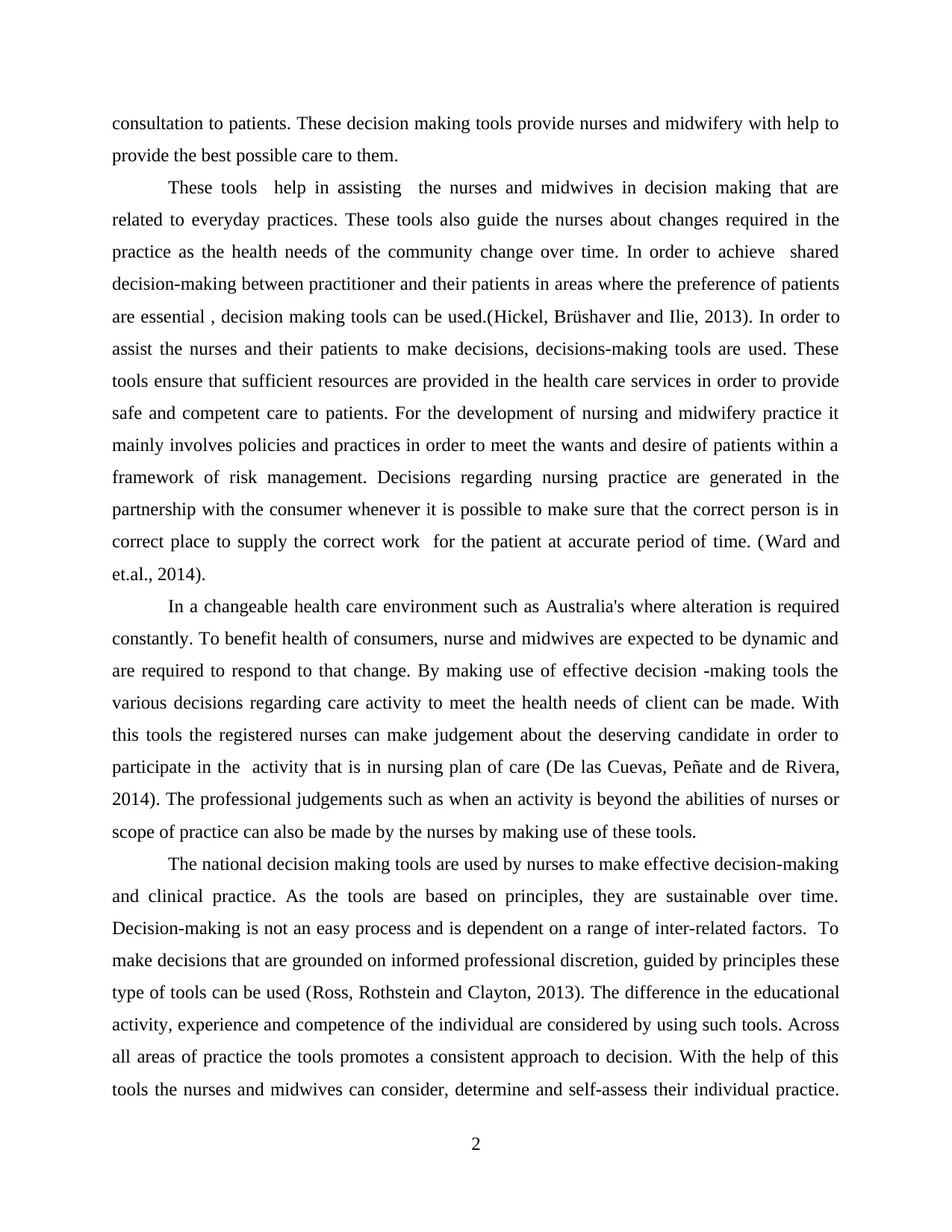
consultation to patients. These decision making tools provide nurses and midwifery with help to
provide the best possible care to them.
These tools help in assisting the nurses and midwives in decision making that are
related to everyday practices. These tools also guide the nurses about changes required in the
practice as the health needs of the community change over time. In order to achieve shared
decision-making between practitioner and their patients in areas where the preference of patients
are essential , decision making tools can be used.(Hickel, Brüshaver and Ilie, 2013). In order to
assist the nurses and their patients to make decisions, decisions-making tools are used. These
tools ensure that sufficient resources are provided in the health care services in order to provide
safe and competent care to patients. For the development of nursing and midwifery practice it
mainly involves policies and practices in order to meet the wants and desire of patients within a
framework of risk management. Decisions regarding nursing practice are generated in the
partnership with the consumer whenever it is possible to make sure that the correct person is in
correct place to supply the correct work for the patient at accurate period of time. (Ward and
et.al., 2014).
In a changeable health care environment such as Australia's where alteration is required
constantly. To benefit health of consumers, nurse and midwives are expected to be dynamic and
are required to respond to that change. By making use of effective decision -making tools the
various decisions regarding care activity to meet the health needs of client can be made. With
this tools the registered nurses can make judgement about the deserving candidate in order to
participate in the activity that is in nursing plan of care (De las Cuevas, Peñate and de Rivera,
2014). The professional judgements such as when an activity is beyond the abilities of nurses or
scope of practice can also be made by the nurses by making use of these tools.
The national decision making tools are used by nurses to make effective decision-making
and clinical practice. As the tools are based on principles, they are sustainable over time.
Decision-making is not an easy process and is dependent on a range of inter-related factors. To
make decisions that are grounded on informed professional discretion, guided by principles these
type of tools can be used (Ross, Rothstein and Clayton, 2013). The difference in the educational
activity, experience and competence of the individual are considered by using such tools. Across
all areas of practice the tools promotes a consistent approach to decision. With the help of this
tools the nurses and midwives can consider, determine and self-assess their individual practice.
2
provide the best possible care to them.
These tools help in assisting the nurses and midwives in decision making that are
related to everyday practices. These tools also guide the nurses about changes required in the
practice as the health needs of the community change over time. In order to achieve shared
decision-making between practitioner and their patients in areas where the preference of patients
are essential , decision making tools can be used.(Hickel, Brüshaver and Ilie, 2013). In order to
assist the nurses and their patients to make decisions, decisions-making tools are used. These
tools ensure that sufficient resources are provided in the health care services in order to provide
safe and competent care to patients. For the development of nursing and midwifery practice it
mainly involves policies and practices in order to meet the wants and desire of patients within a
framework of risk management. Decisions regarding nursing practice are generated in the
partnership with the consumer whenever it is possible to make sure that the correct person is in
correct place to supply the correct work for the patient at accurate period of time. (Ward and
et.al., 2014).
In a changeable health care environment such as Australia's where alteration is required
constantly. To benefit health of consumers, nurse and midwives are expected to be dynamic and
are required to respond to that change. By making use of effective decision -making tools the
various decisions regarding care activity to meet the health needs of client can be made. With
this tools the registered nurses can make judgement about the deserving candidate in order to
participate in the activity that is in nursing plan of care (De las Cuevas, Peñate and de Rivera,
2014). The professional judgements such as when an activity is beyond the abilities of nurses or
scope of practice can also be made by the nurses by making use of these tools.
The national decision making tools are used by nurses to make effective decision-making
and clinical practice. As the tools are based on principles, they are sustainable over time.
Decision-making is not an easy process and is dependent on a range of inter-related factors. To
make decisions that are grounded on informed professional discretion, guided by principles these
type of tools can be used (Ross, Rothstein and Clayton, 2013). The difference in the educational
activity, experience and competence of the individual are considered by using such tools. Across
all areas of practice the tools promotes a consistent approach to decision. With the help of this
tools the nurses and midwives can consider, determine and self-assess their individual practice.
2
Paraphrase This Document
Need a fresh take? Get an instant paraphrase of this document with our AI Paraphraser
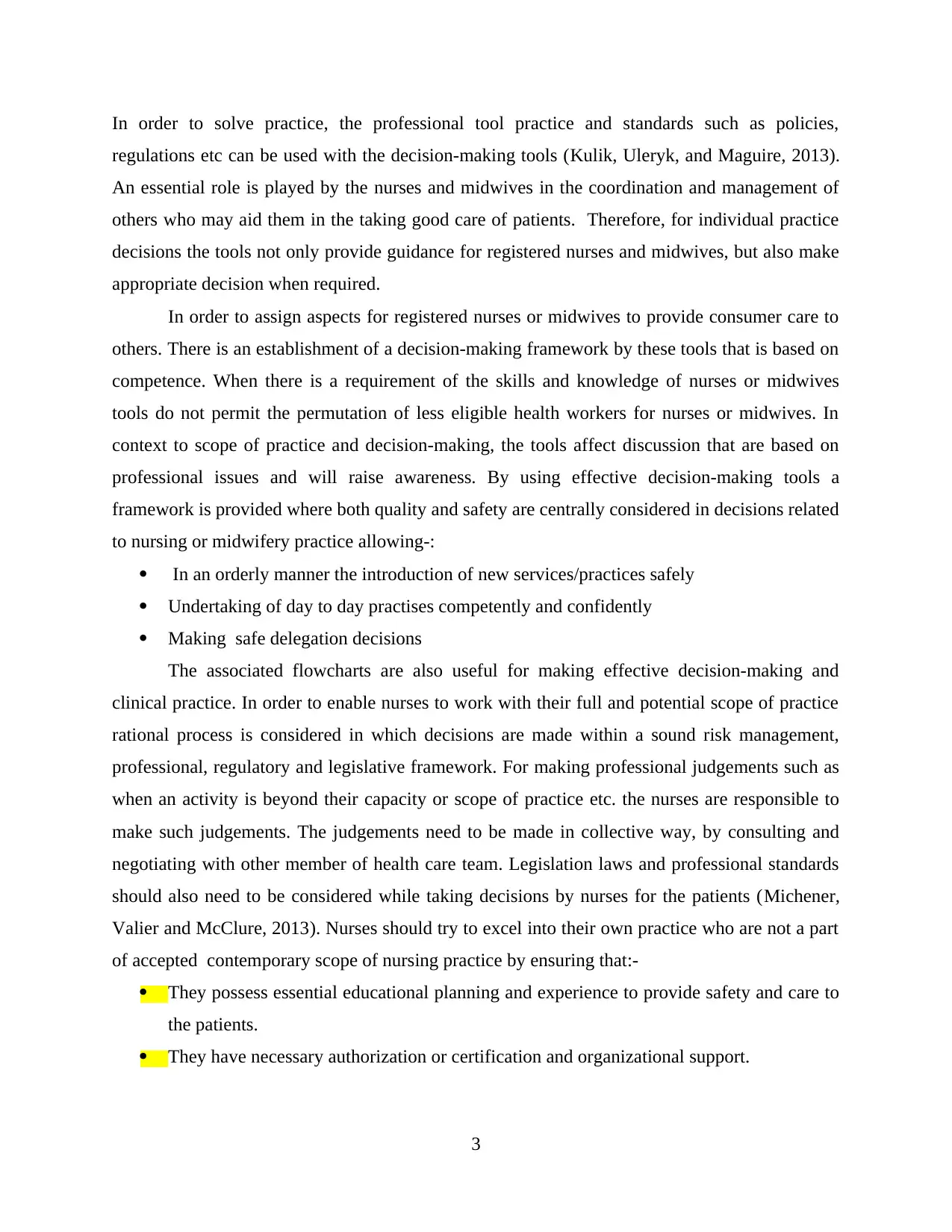
In order to solve practice, the professional tool practice and standards such as policies,
regulations etc can be used with the decision-making tools (Kulik, Uleryk, and Maguire, 2013).
An essential role is played by the nurses and midwives in the coordination and management of
others who may aid them in the taking good care of patients. Therefore, for individual practice
decisions the tools not only provide guidance for registered nurses and midwives, but also make
appropriate decision when required.
In order to assign aspects for registered nurses or midwives to provide consumer care to
others. There is an establishment of a decision-making framework by these tools that is based on
competence. When there is a requirement of the skills and knowledge of nurses or midwives
tools do not permit the permutation of less eligible health workers for nurses or midwives. In
context to scope of practice and decision-making, the tools affect discussion that are based on
professional issues and will raise awareness. By using effective decision-making tools a
framework is provided where both quality and safety are centrally considered in decisions related
to nursing or midwifery practice allowing-:
In an orderly manner the introduction of new services/practices safely
Undertaking of day to day practises competently and confidently
Making safe delegation decisions
The associated flowcharts are also useful for making effective decision-making and
clinical practice. In order to enable nurses to work with their full and potential scope of practice
rational process is considered in which decisions are made within a sound risk management,
professional, regulatory and legislative framework. For making professional judgements such as
when an activity is beyond their capacity or scope of practice etc. the nurses are responsible to
make such judgements. The judgements need to be made in collective way, by consulting and
negotiating with other member of health care team. Legislation laws and professional standards
should also need to be considered while taking decisions by nurses for the patients (Michener,
Valier and McClure, 2013). Nurses should try to excel into their own practice who are not a part
of accepted contemporary scope of nursing practice by ensuring that:-
They possess essential educational planning and experience to provide safety and care to
the patients.
They have necessary authorization or certification and organizational support.
3
regulations etc can be used with the decision-making tools (Kulik, Uleryk, and Maguire, 2013).
An essential role is played by the nurses and midwives in the coordination and management of
others who may aid them in the taking good care of patients. Therefore, for individual practice
decisions the tools not only provide guidance for registered nurses and midwives, but also make
appropriate decision when required.
In order to assign aspects for registered nurses or midwives to provide consumer care to
others. There is an establishment of a decision-making framework by these tools that is based on
competence. When there is a requirement of the skills and knowledge of nurses or midwives
tools do not permit the permutation of less eligible health workers for nurses or midwives. In
context to scope of practice and decision-making, the tools affect discussion that are based on
professional issues and will raise awareness. By using effective decision-making tools a
framework is provided where both quality and safety are centrally considered in decisions related
to nursing or midwifery practice allowing-:
In an orderly manner the introduction of new services/practices safely
Undertaking of day to day practises competently and confidently
Making safe delegation decisions
The associated flowcharts are also useful for making effective decision-making and
clinical practice. In order to enable nurses to work with their full and potential scope of practice
rational process is considered in which decisions are made within a sound risk management,
professional, regulatory and legislative framework. For making professional judgements such as
when an activity is beyond their capacity or scope of practice etc. the nurses are responsible to
make such judgements. The judgements need to be made in collective way, by consulting and
negotiating with other member of health care team. Legislation laws and professional standards
should also need to be considered while taking decisions by nurses for the patients (Michener,
Valier and McClure, 2013). Nurses should try to excel into their own practice who are not a part
of accepted contemporary scope of nursing practice by ensuring that:-
They possess essential educational planning and experience to provide safety and care to
the patients.
They have necessary authorization or certification and organizational support.
3
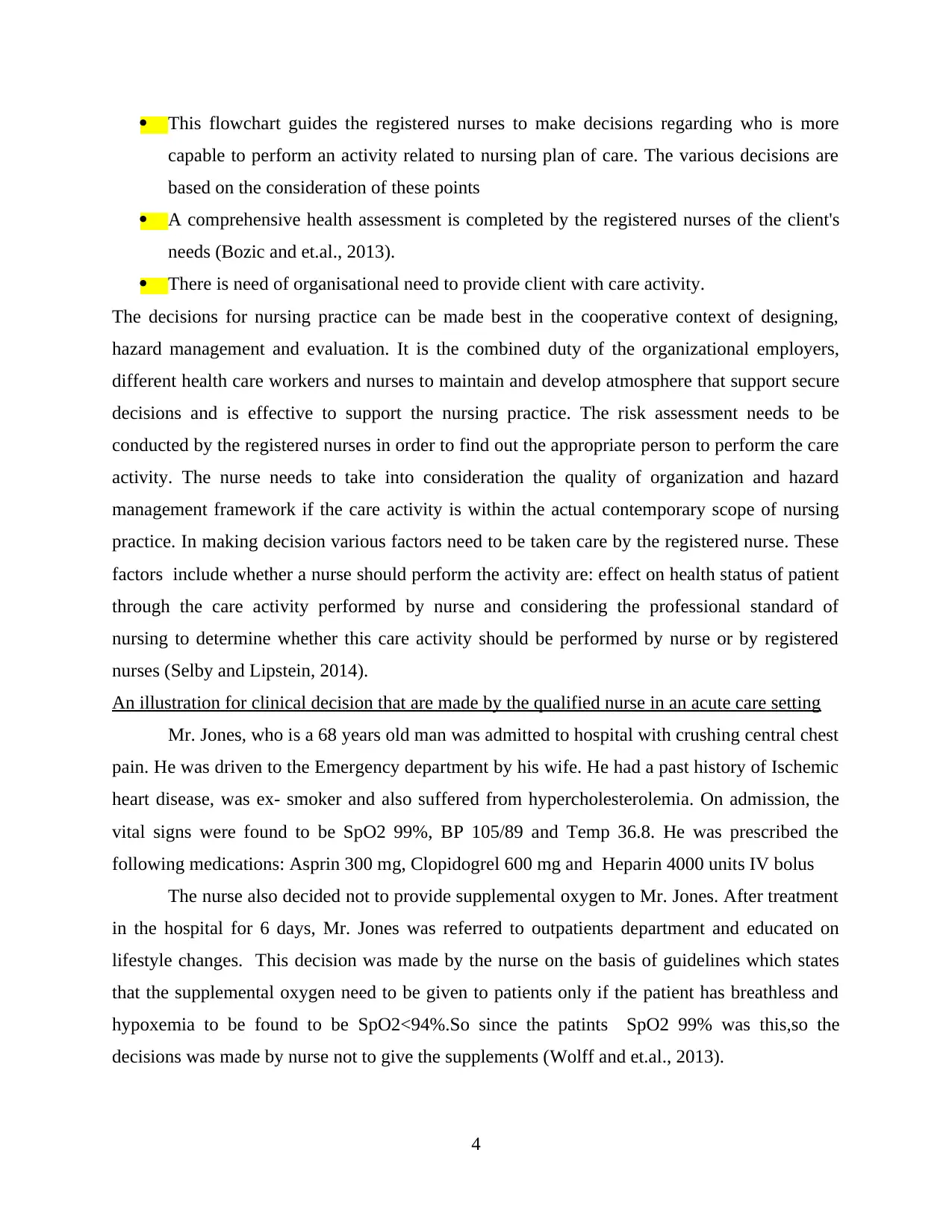
This flowchart guides the registered nurses to make decisions regarding who is more
capable to perform an activity related to nursing plan of care. The various decisions are
based on the consideration of these points
A comprehensive health assessment is completed by the registered nurses of the client's
needs (Bozic and et.al., 2013).
There is need of organisational need to provide client with care activity.
The decisions for nursing practice can be made best in the cooperative context of designing,
hazard management and evaluation. It is the combined duty of the organizational employers,
different health care workers and nurses to maintain and develop atmosphere that support secure
decisions and is effective to support the nursing practice. The risk assessment needs to be
conducted by the registered nurses in order to find out the appropriate person to perform the care
activity. The nurse needs to take into consideration the quality of organization and hazard
management framework if the care activity is within the actual contemporary scope of nursing
practice. In making decision various factors need to be taken care by the registered nurse. These
factors include whether a nurse should perform the activity are: effect on health status of patient
through the care activity performed by nurse and considering the professional standard of
nursing to determine whether this care activity should be performed by nurse or by registered
nurses (Selby and Lipstein, 2014).
An illustration for clinical decision that are made by the qualified nurse in an acute care setting
Mr. Jones, who is a 68 years old man was admitted to hospital with crushing central chest
pain. He was driven to the Emergency department by his wife. He had a past history of Ischemic
heart disease, was ex- smoker and also suffered from hypercholesterolemia. On admission, the
vital signs were found to be SpO2 99%, BP 105/89 and Temp 36.8. He was prescribed the
following medications: Asprin 300 mg, Clopidogrel 600 mg and Heparin 4000 units IV bolus
The nurse also decided not to provide supplemental oxygen to Mr. Jones. After treatment
in the hospital for 6 days, Mr. Jones was referred to outpatients department and educated on
lifestyle changes. This decision was made by the nurse on the basis of guidelines which states
that the supplemental oxygen need to be given to patients only if the patient has breathless and
hypoxemia to be found to be SpO2<94%.So since the patints SpO2 99% was this,so the
decisions was made by nurse not to give the supplements (Wolff and et.al., 2013).
4
capable to perform an activity related to nursing plan of care. The various decisions are
based on the consideration of these points
A comprehensive health assessment is completed by the registered nurses of the client's
needs (Bozic and et.al., 2013).
There is need of organisational need to provide client with care activity.
The decisions for nursing practice can be made best in the cooperative context of designing,
hazard management and evaluation. It is the combined duty of the organizational employers,
different health care workers and nurses to maintain and develop atmosphere that support secure
decisions and is effective to support the nursing practice. The risk assessment needs to be
conducted by the registered nurses in order to find out the appropriate person to perform the care
activity. The nurse needs to take into consideration the quality of organization and hazard
management framework if the care activity is within the actual contemporary scope of nursing
practice. In making decision various factors need to be taken care by the registered nurse. These
factors include whether a nurse should perform the activity are: effect on health status of patient
through the care activity performed by nurse and considering the professional standard of
nursing to determine whether this care activity should be performed by nurse or by registered
nurses (Selby and Lipstein, 2014).
An illustration for clinical decision that are made by the qualified nurse in an acute care setting
Mr. Jones, who is a 68 years old man was admitted to hospital with crushing central chest
pain. He was driven to the Emergency department by his wife. He had a past history of Ischemic
heart disease, was ex- smoker and also suffered from hypercholesterolemia. On admission, the
vital signs were found to be SpO2 99%, BP 105/89 and Temp 36.8. He was prescribed the
following medications: Asprin 300 mg, Clopidogrel 600 mg and Heparin 4000 units IV bolus
The nurse also decided not to provide supplemental oxygen to Mr. Jones. After treatment
in the hospital for 6 days, Mr. Jones was referred to outpatients department and educated on
lifestyle changes. This decision was made by the nurse on the basis of guidelines which states
that the supplemental oxygen need to be given to patients only if the patient has breathless and
hypoxemia to be found to be SpO2<94%.So since the patints SpO2 99% was this,so the
decisions was made by nurse not to give the supplements (Wolff and et.al., 2013).
4
⊘ This is a preview!⊘
Do you want full access?
Subscribe today to unlock all pages.

Trusted by 1+ million students worldwide
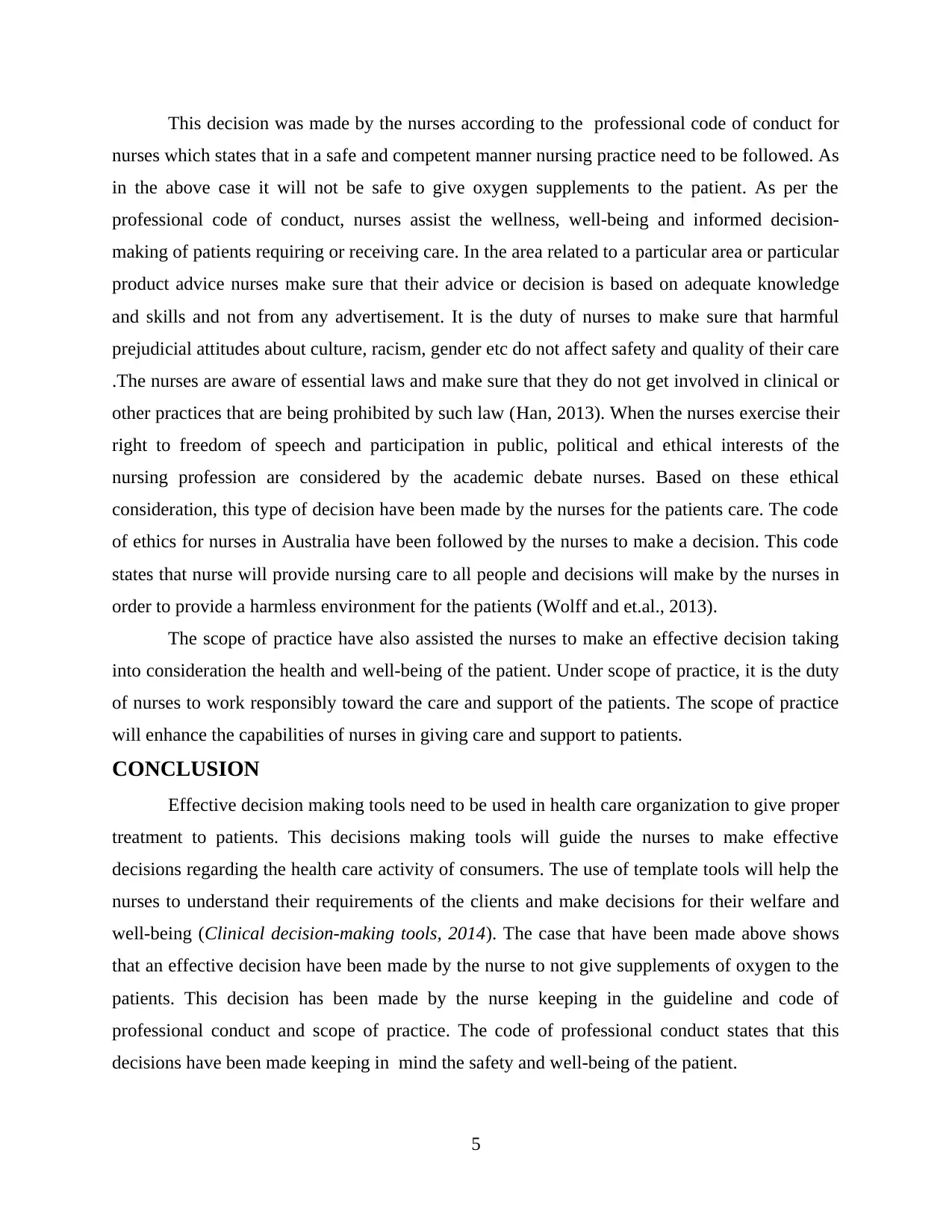
This decision was made by the nurses according to the professional code of conduct for
nurses which states that in a safe and competent manner nursing practice need to be followed. As
in the above case it will not be safe to give oxygen supplements to the patient. As per the
professional code of conduct, nurses assist the wellness, well-being and informed decision-
making of patients requiring or receiving care. In the area related to a particular area or particular
product advice nurses make sure that their advice or decision is based on adequate knowledge
and skills and not from any advertisement. It is the duty of nurses to make sure that harmful
prejudicial attitudes about culture, racism, gender etc do not affect safety and quality of their care
.The nurses are aware of essential laws and make sure that they do not get involved in clinical or
other practices that are being prohibited by such law (Han, 2013). When the nurses exercise their
right to freedom of speech and participation in public, political and ethical interests of the
nursing profession are considered by the academic debate nurses. Based on these ethical
consideration, this type of decision have been made by the nurses for the patients care. The code
of ethics for nurses in Australia have been followed by the nurses to make a decision. This code
states that nurse will provide nursing care to all people and decisions will make by the nurses in
order to provide a harmless environment for the patients (Wolff and et.al., 2013).
The scope of practice have also assisted the nurses to make an effective decision taking
into consideration the health and well-being of the patient. Under scope of practice, it is the duty
of nurses to work responsibly toward the care and support of the patients. The scope of practice
will enhance the capabilities of nurses in giving care and support to patients.
CONCLUSION
Effective decision making tools need to be used in health care organization to give proper
treatment to patients. This decisions making tools will guide the nurses to make effective
decisions regarding the health care activity of consumers. The use of template tools will help the
nurses to understand their requirements of the clients and make decisions for their welfare and
well-being (Clinical decision-making tools, 2014). The case that have been made above shows
that an effective decision have been made by the nurse to not give supplements of oxygen to the
patients. This decision has been made by the nurse keeping in the guideline and code of
professional conduct and scope of practice. The code of professional conduct states that this
decisions have been made keeping in mind the safety and well-being of the patient.
5
nurses which states that in a safe and competent manner nursing practice need to be followed. As
in the above case it will not be safe to give oxygen supplements to the patient. As per the
professional code of conduct, nurses assist the wellness, well-being and informed decision-
making of patients requiring or receiving care. In the area related to a particular area or particular
product advice nurses make sure that their advice or decision is based on adequate knowledge
and skills and not from any advertisement. It is the duty of nurses to make sure that harmful
prejudicial attitudes about culture, racism, gender etc do not affect safety and quality of their care
.The nurses are aware of essential laws and make sure that they do not get involved in clinical or
other practices that are being prohibited by such law (Han, 2013). When the nurses exercise their
right to freedom of speech and participation in public, political and ethical interests of the
nursing profession are considered by the academic debate nurses. Based on these ethical
consideration, this type of decision have been made by the nurses for the patients care. The code
of ethics for nurses in Australia have been followed by the nurses to make a decision. This code
states that nurse will provide nursing care to all people and decisions will make by the nurses in
order to provide a harmless environment for the patients (Wolff and et.al., 2013).
The scope of practice have also assisted the nurses to make an effective decision taking
into consideration the health and well-being of the patient. Under scope of practice, it is the duty
of nurses to work responsibly toward the care and support of the patients. The scope of practice
will enhance the capabilities of nurses in giving care and support to patients.
CONCLUSION
Effective decision making tools need to be used in health care organization to give proper
treatment to patients. This decisions making tools will guide the nurses to make effective
decisions regarding the health care activity of consumers. The use of template tools will help the
nurses to understand their requirements of the clients and make decisions for their welfare and
well-being (Clinical decision-making tools, 2014). The case that have been made above shows
that an effective decision have been made by the nurse to not give supplements of oxygen to the
patients. This decision has been made by the nurse keeping in the guideline and code of
professional conduct and scope of practice. The code of professional conduct states that this
decisions have been made keeping in mind the safety and well-being of the patient.
5
Paraphrase This Document
Need a fresh take? Get an instant paraphrase of this document with our AI Paraphraser
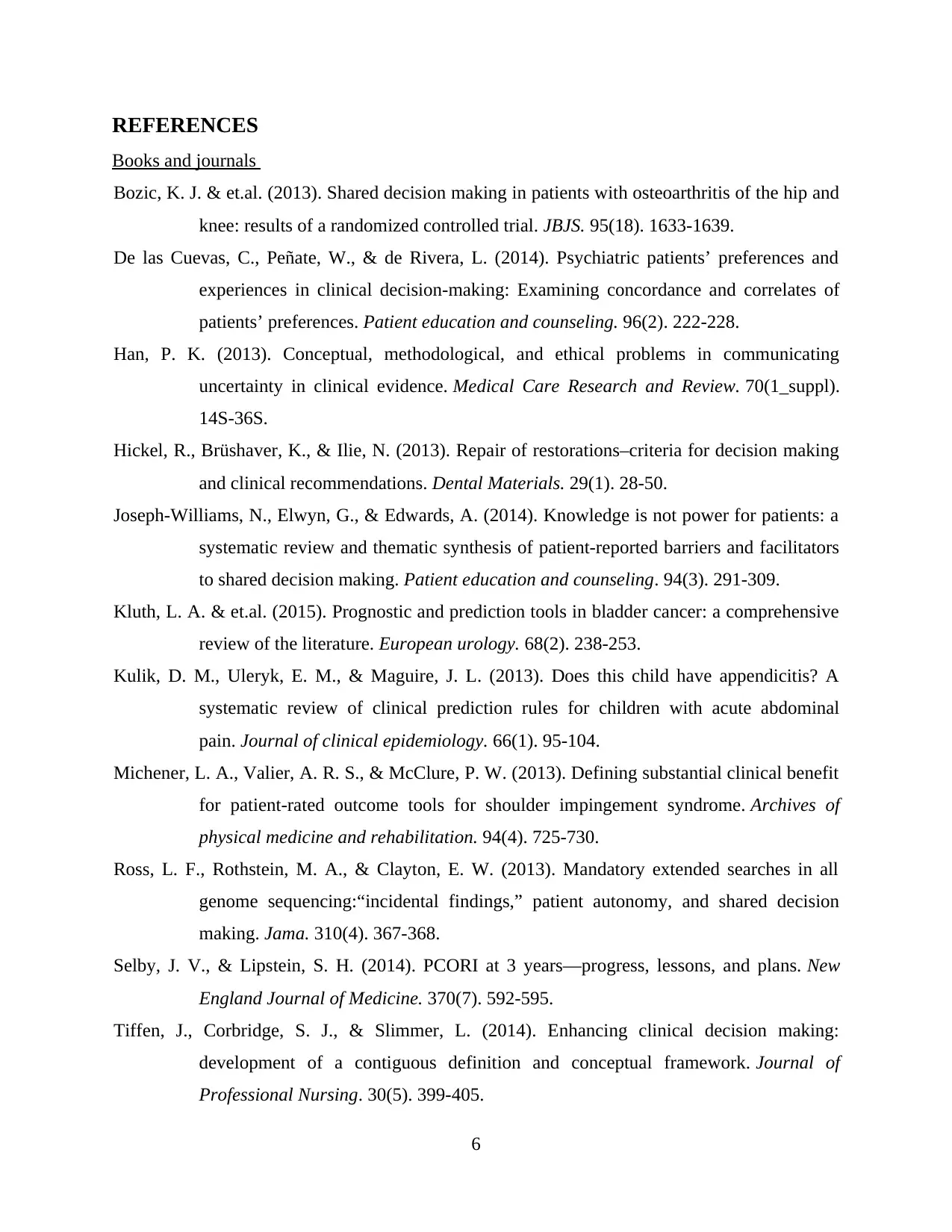
REFERENCES
Books and journals
Bozic, K. J. & et.al. (2013). Shared decision making in patients with osteoarthritis of the hip and
knee: results of a randomized controlled trial. JBJS. 95(18). 1633-1639.
De las Cuevas, C., Peñate, W., & de Rivera, L. (2014). Psychiatric patients’ preferences and
experiences in clinical decision-making: Examining concordance and correlates of
patients’ preferences. Patient education and counseling. 96(2). 222-228.
Han, P. K. (2013). Conceptual, methodological, and ethical problems in communicating
uncertainty in clinical evidence. Medical Care Research and Review. 70(1_suppl).
14S-36S.
Hickel, R., Brüshaver, K., & Ilie, N. (2013). Repair of restorations–criteria for decision making
and clinical recommendations. Dental Materials. 29(1). 28-50.
Joseph-Williams, N., Elwyn, G., & Edwards, A. (2014). Knowledge is not power for patients: a
systematic review and thematic synthesis of patient-reported barriers and facilitators
to shared decision making. Patient education and counseling. 94(3). 291-309.
Kluth, L. A. & et.al. (2015). Prognostic and prediction tools in bladder cancer: a comprehensive
review of the literature. European urology. 68(2). 238-253.
Kulik, D. M., Uleryk, E. M., & Maguire, J. L. (2013). Does this child have appendicitis? A
systematic review of clinical prediction rules for children with acute abdominal
pain. Journal of clinical epidemiology. 66(1). 95-104.
Michener, L. A., Valier, A. R. S., & McClure, P. W. (2013). Defining substantial clinical benefit
for patient-rated outcome tools for shoulder impingement syndrome. Archives of
physical medicine and rehabilitation. 94(4). 725-730.
Ross, L. F., Rothstein, M. A., & Clayton, E. W. (2013). Mandatory extended searches in all
genome sequencing:“incidental findings,” patient autonomy, and shared decision
making. Jama. 310(4). 367-368.
Selby, J. V., & Lipstein, S. H. (2014). PCORI at 3 years—progress, lessons, and plans. New
England Journal of Medicine. 370(7). 592-595.
Tiffen, J., Corbridge, S. J., & Slimmer, L. (2014). Enhancing clinical decision making:
development of a contiguous definition and conceptual framework. Journal of
Professional Nursing. 30(5). 399-405.
6
Books and journals
Bozic, K. J. & et.al. (2013). Shared decision making in patients with osteoarthritis of the hip and
knee: results of a randomized controlled trial. JBJS. 95(18). 1633-1639.
De las Cuevas, C., Peñate, W., & de Rivera, L. (2014). Psychiatric patients’ preferences and
experiences in clinical decision-making: Examining concordance and correlates of
patients’ preferences. Patient education and counseling. 96(2). 222-228.
Han, P. K. (2013). Conceptual, methodological, and ethical problems in communicating
uncertainty in clinical evidence. Medical Care Research and Review. 70(1_suppl).
14S-36S.
Hickel, R., Brüshaver, K., & Ilie, N. (2013). Repair of restorations–criteria for decision making
and clinical recommendations. Dental Materials. 29(1). 28-50.
Joseph-Williams, N., Elwyn, G., & Edwards, A. (2014). Knowledge is not power for patients: a
systematic review and thematic synthesis of patient-reported barriers and facilitators
to shared decision making. Patient education and counseling. 94(3). 291-309.
Kluth, L. A. & et.al. (2015). Prognostic and prediction tools in bladder cancer: a comprehensive
review of the literature. European urology. 68(2). 238-253.
Kulik, D. M., Uleryk, E. M., & Maguire, J. L. (2013). Does this child have appendicitis? A
systematic review of clinical prediction rules for children with acute abdominal
pain. Journal of clinical epidemiology. 66(1). 95-104.
Michener, L. A., Valier, A. R. S., & McClure, P. W. (2013). Defining substantial clinical benefit
for patient-rated outcome tools for shoulder impingement syndrome. Archives of
physical medicine and rehabilitation. 94(4). 725-730.
Ross, L. F., Rothstein, M. A., & Clayton, E. W. (2013). Mandatory extended searches in all
genome sequencing:“incidental findings,” patient autonomy, and shared decision
making. Jama. 310(4). 367-368.
Selby, J. V., & Lipstein, S. H. (2014). PCORI at 3 years—progress, lessons, and plans. New
England Journal of Medicine. 370(7). 592-595.
Tiffen, J., Corbridge, S. J., & Slimmer, L. (2014). Enhancing clinical decision making:
development of a contiguous definition and conceptual framework. Journal of
Professional Nursing. 30(5). 399-405.
6
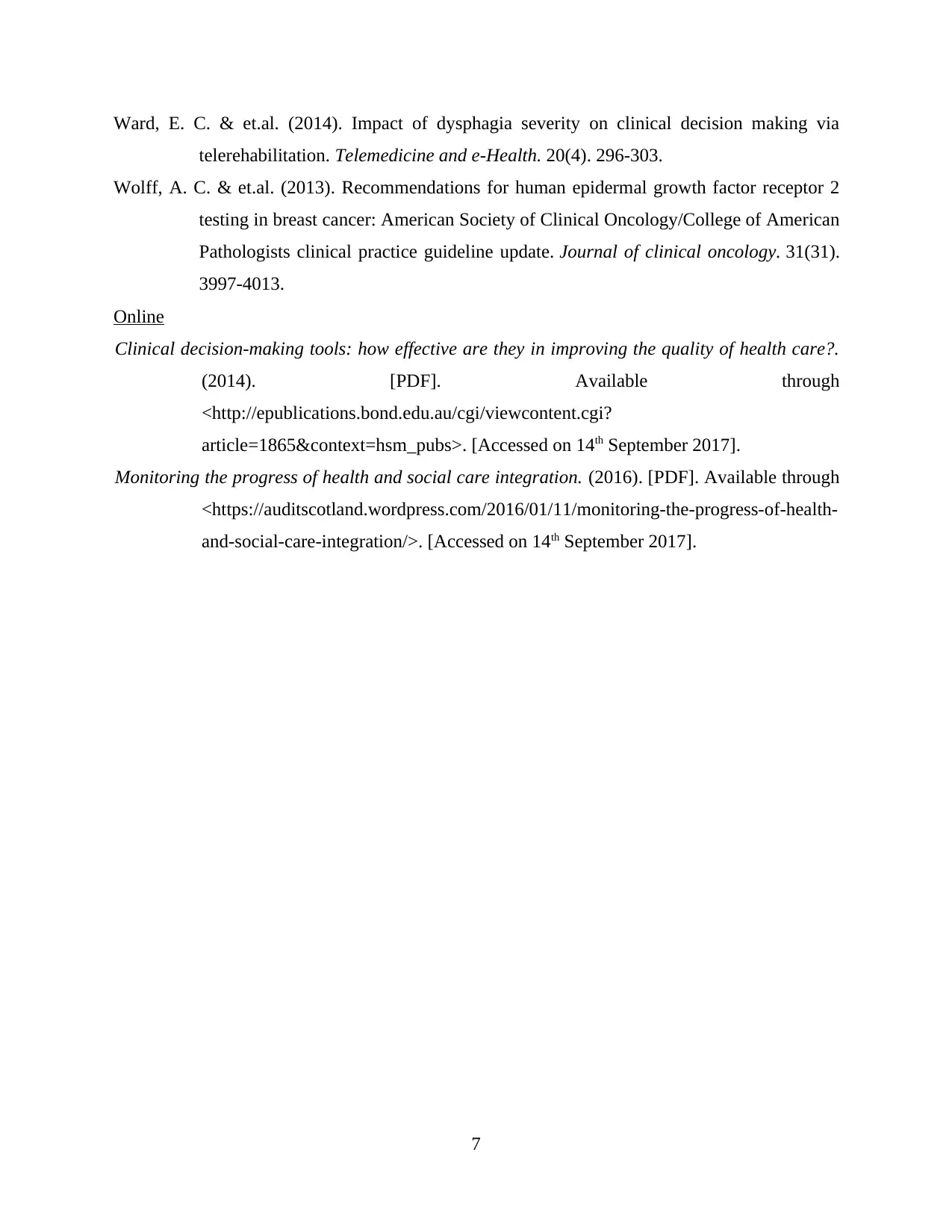
Ward, E. C. & et.al. (2014). Impact of dysphagia severity on clinical decision making via
telerehabilitation. Telemedicine and e-Health. 20(4). 296-303.
Wolff, A. C. & et.al. (2013). Recommendations for human epidermal growth factor receptor 2
testing in breast cancer: American Society of Clinical Oncology/College of American
Pathologists clinical practice guideline update. Journal of clinical oncology. 31(31).
3997-4013.
Online
Clinical decision-making tools: how effective are they in improving the quality of health care?.
(2014). [PDF]. Available through
<http://epublications.bond.edu.au/cgi/viewcontent.cgi?
article=1865&context=hsm_pubs>. [Accessed on 14th September 2017].
Monitoring the progress of health and social care integration. (2016). [PDF]. Available through
<https://auditscotland.wordpress.com/2016/01/11/monitoring-the-progress-of-health-
and-social-care-integration/>. [Accessed on 14th September 2017].
7
telerehabilitation. Telemedicine and e-Health. 20(4). 296-303.
Wolff, A. C. & et.al. (2013). Recommendations for human epidermal growth factor receptor 2
testing in breast cancer: American Society of Clinical Oncology/College of American
Pathologists clinical practice guideline update. Journal of clinical oncology. 31(31).
3997-4013.
Online
Clinical decision-making tools: how effective are they in improving the quality of health care?.
(2014). [PDF]. Available through
<http://epublications.bond.edu.au/cgi/viewcontent.cgi?
article=1865&context=hsm_pubs>. [Accessed on 14th September 2017].
Monitoring the progress of health and social care integration. (2016). [PDF]. Available through
<https://auditscotland.wordpress.com/2016/01/11/monitoring-the-progress-of-health-
and-social-care-integration/>. [Accessed on 14th September 2017].
7
⊘ This is a preview!⊘
Do you want full access?
Subscribe today to unlock all pages.

Trusted by 1+ million students worldwide
1 out of 9
Related Documents
Your All-in-One AI-Powered Toolkit for Academic Success.
+13062052269
info@desklib.com
Available 24*7 on WhatsApp / Email
![[object Object]](/_next/static/media/star-bottom.7253800d.svg)
Unlock your academic potential
Copyright © 2020–2025 A2Z Services. All Rights Reserved. Developed and managed by ZUCOL.





